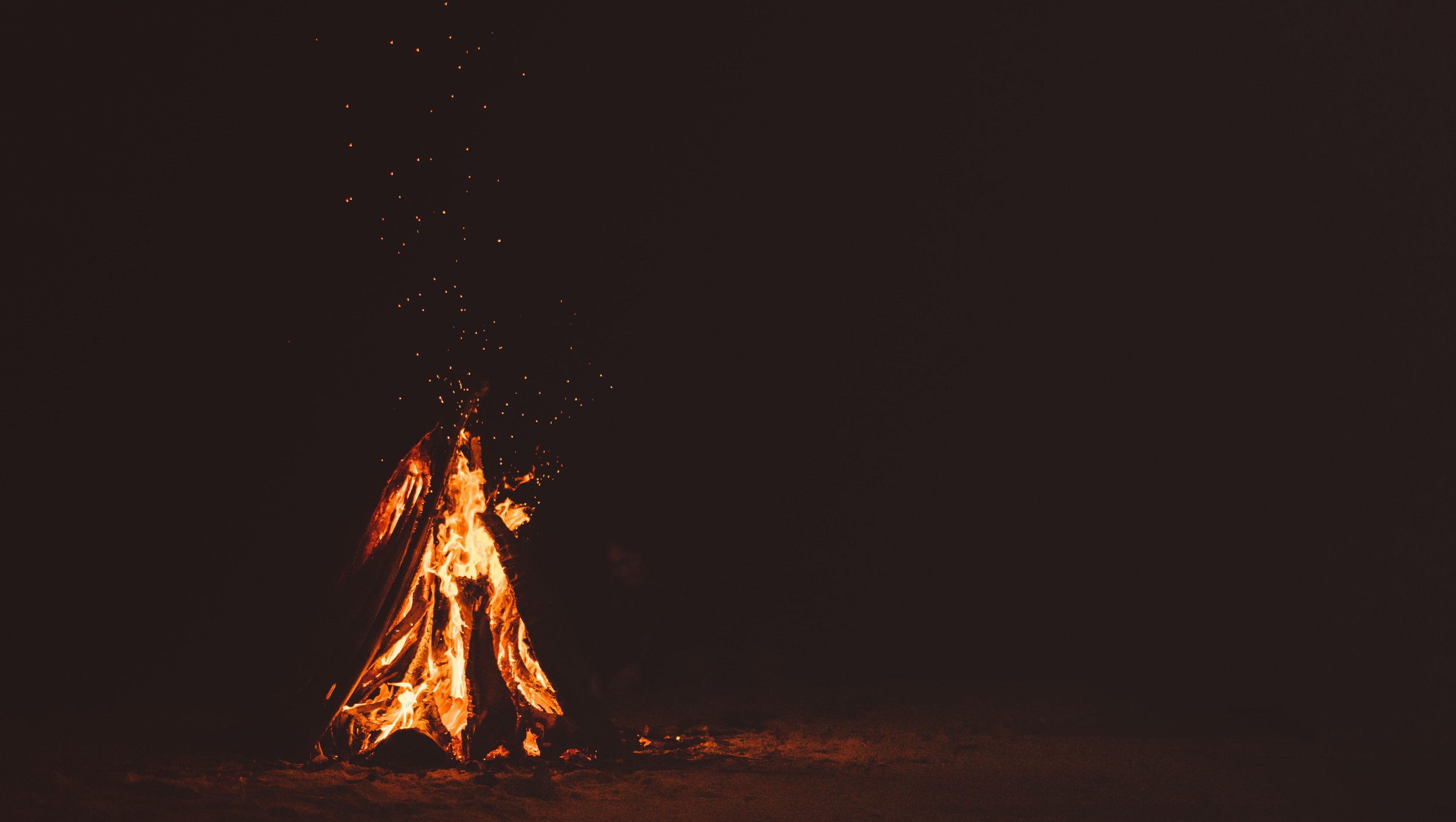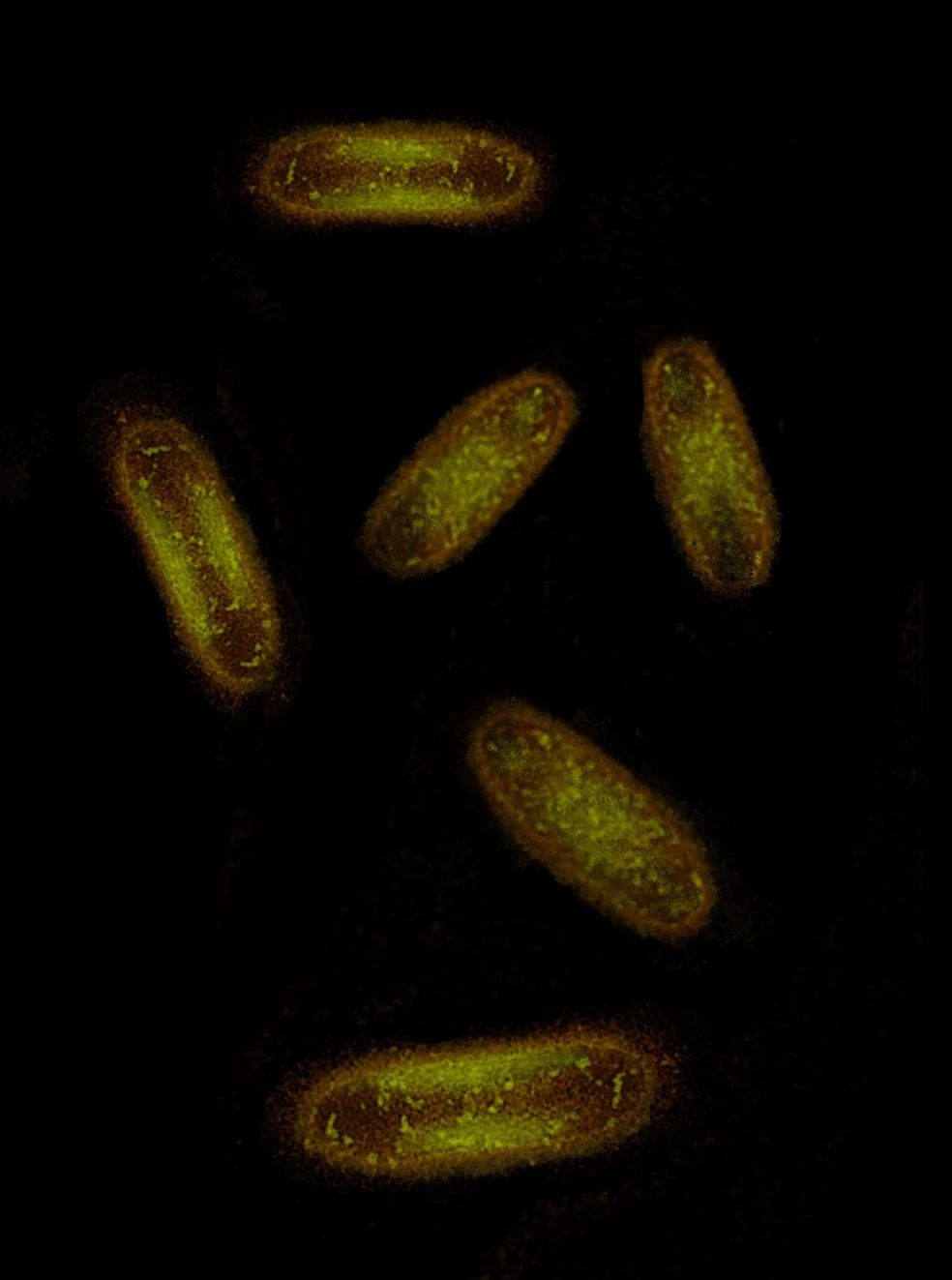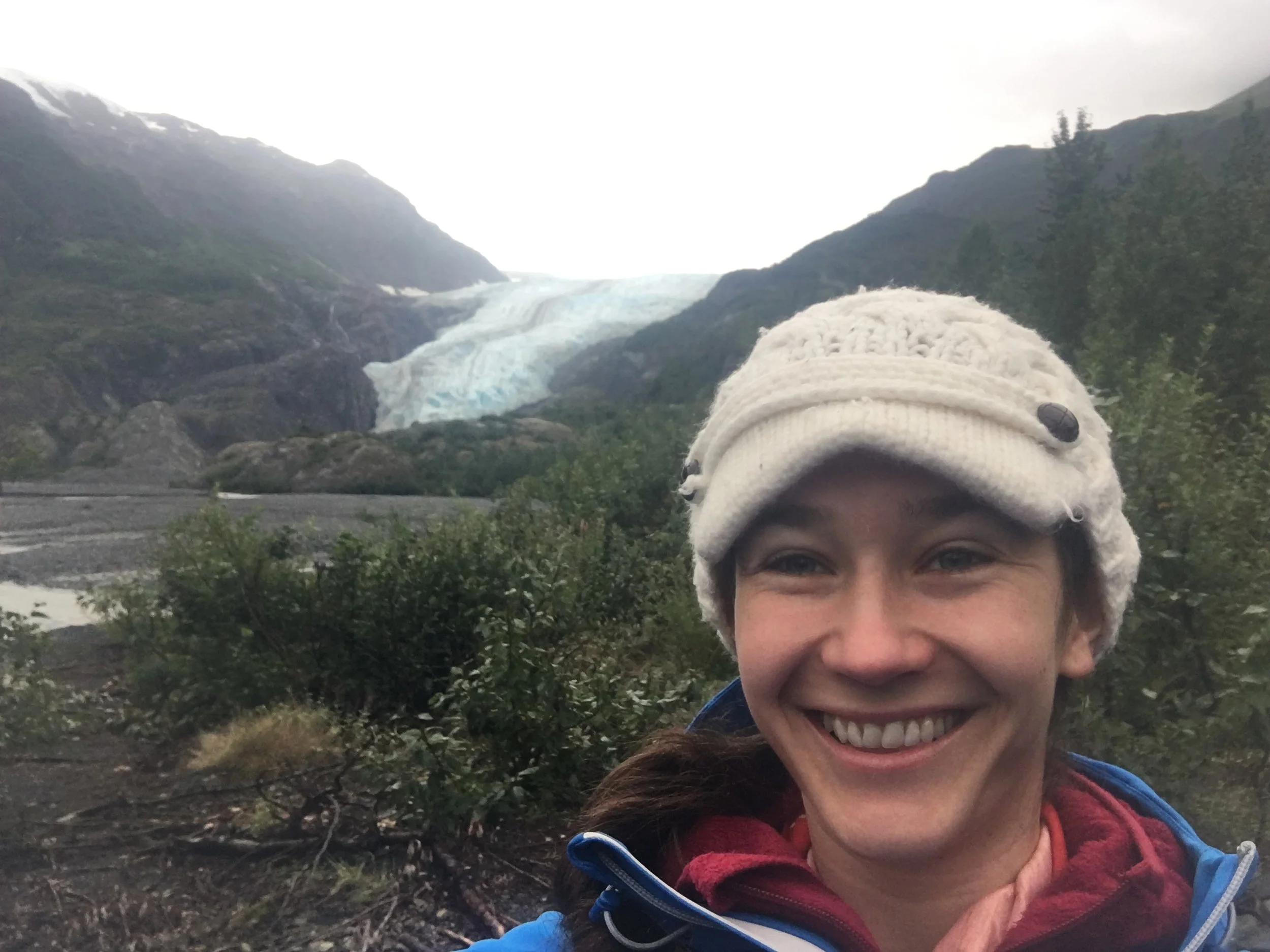Ancient Community Aided Prehistoric Woman with Chronic Illness
CT scans help bioarchaeologist uncover a debilitating case of brucellosis
Image credit: Tara Holley with elements from Unsplash
by Annabelle Moore
May 19, 2022
Imagine an autumn Texas evening, the toasty kind that glows golden as the heat of the day slowly lifts from the baked earth. Fluffy white cottonwood seeds float lazily in the air while a woman sits near an earth oven pit, carefully breaking down a black-tailed jackrabbit. With a sharp flint stone knife, she deftly slices into the soft fur and strips back the skin in one tidy piece, saving it for future projects. Baked rabbit, paired with roasted succulents like sotol, the spiky “desert spoon” plant, and pecans, makes a delicious meal.
Her bracelets of carved shell and bone beads make a soft rhythmic rattle as they clatter back and forth. She divides the rabbit’s small frame, parting out slender slices of meat. As the animal’s warm juices spill across her hands, a wholly unknown microscopic organism finds its way into a half-healed scrape on her palm. This woman, an ancient hunter-gatherer living 4,000-1,300 years ago in what will one day be the Lower Pecos Canyonlands, will never know bacteria infected her, or how it triggered a disease that would change her life forever.
Map of Fate Bell Shelter and the Lower Pecos archaeological region where the remains of 758a were uncovered. Image credit: Christine Jones.
Seminole Canyon carves through the creosote scrub and prickly pear cactus landscape near Comstock, Texas and the Mexican border. Thousands of years ago, dangerous microbes spilled from wild animals to infect human communities just as they do today. We’re familiar with the word “zoonosis” because of the COVID-19 pandemic. But parasites, bacteria, viruses, prions, and fungi — microscopic organisms that cause zoonotic diseases — have been part of human life as long as we have been on Earth.
The woman lived at the Fate Bell rock shelter during the Middle (4,000-2,300 B.P.) to Late (2,300-1,300 B.P.) Archaic period in what is now Seminole Canyon State Park and Historic Site. Today, her community is famous for the rock art they left on the canyon walls of their home. We’ll never know exactly how or when she was infected, but archaeologists believe it likely came from exposure to wildlife like desert cottontails or black-tailed jackrabbits. Her skeleton now tells a new story of survival.
She was found by archaeologists from the University of Texas at Austin during an excavation in the 1930s. Her true name remains a mystery lost to time. Identified as “individual 758a,” her skeleton resides at the Texas Archaeological Research Laboratory in Austin. Christine Jones, a bioarchaeologist at Texas A&M University-Central Texas in Killeen, analyzed the pelvis and skull to determine gender and estimated the woman lived to be between 46 and 90 years old. This was a surprisingly long life for someone with a debilitating chronic brucellosis infection. Hers was the first skeleton to be diagnosed with brucellosis using CT scans and only the second prehistoric skeleton identified with brucellosis in North America. How did she survive the challenges of her unknown disease?
Jones detected clues about the diet, injuries, and physical challenges experienced in life by examining what the ancient woman left behind: her bones. The unusual holes, unforgiving bone spurs, and curious pattern of damage seen on the female’s skeleton caught Jones’ attention during her doctoral degree research. When none of her professors could definitively explain what caused the large holes — cancer? invasive plant roots? a bug digging over time through the burial? — Jones decided to find out. “Prehistory is cool because it’s just ancient,” said Jones. “We don’t have a historic record, so we have no choice but to look at the archaeology.”
Archaeologists believe prehistoric people lived in small family bands of five to 10 people. Life in prehistory was dangerous; the woman couldn’t have lived so long without help. She would have known everyone in her group and likely other groups in the Lower Pecos Canyonland region. “It’s a different way of [living] — everything would have been done by yourself,” said Jones. “I can’t even imagine how they would come at disease. Because disease makes you feel so powerless.”
Artist’s rendering of Brucella bacteria. Image credit: Tara Holley, with elements from the National Institutes of Health
Brucellosis, while seldom lethal, leaves its mark on the bones. Based on the damage caused by the disease over the woman’s lifetime, Jones realized the woman likely needed significant support in daily life. In the archaeological record, said Jones, “there are disabilities [where] you can clearly see there was help — there had to be,” because skeletal remains have been found to show advanced stages of disease. This means individuals experiencing debilitating chronic illness must have received some amount of support to endure the disease over time.
“We have a limited amount of information about her care, what kind of physical care, she had,” said Jones. For the woman to survive to an elderly age in a nomadic society, Jones added, “we know she had to have been cared for food-wise [and] probably to get around.”
A GE Medical Systems Discovery CT scanner allowed Jones to get an inside look at the extent of the infection’s impact. Diseases like brucellosis, tuberculosis, cancer, and rheumatoid arthritis, which Jones considered, are known to leave specific patterns of injury on bones. The woman’s spinal bones, or vertebrae, were scanned in three directions: coronal (front to back), sagittal (left to right), and transverse (upper body to lower body).
The elderly woman had damage deep in her vertebrae including several holes, or lesions, caused by soft bone tissue, and sharp bone fragments shaped like parrots’ beaks on the front of her thoracic vertebrae, caused by the stiffening of soft body tissues. These issues would have given her back and joint pain and severe sciatica (pain that flashes down the long sciatic nerve traveling from the hips into the legs). The scans showed bone features consistent with brucellosis infection along with possible osteoporosis, a diminishing of bone strength and hardness over time that leaves bones frail and more likely to shatter from light injury.
The woman’s prehistoric everyday tasks — collecting nuts and seeds for grinding; foraging prickly pear cactus fruit and pads for earth pit baking; harvesting yucca and bear grass for weaving baskets, sleeping mats, and fiber bags; collecting water; and caring for community children — would have been very challenging.
Brucellosis can cause a constellation of painful symptoms, such as fevers, arthritis, pregnancy complications, fatigue, depression, psychosis, and neurological damage. She may have lost her appetite, had trouble sleeping, experienced headaches, and suffered mood swings. Socially and emotionally, the impacts of brucellosis likely reduced her community interactions and rendered her reliant on others.
It was tough to determine how her group provided care. “We have little cultural history aside from the artifacts,” said Jones. “There’s no living culture to ask or compare to.” Taking care of an ill neighbor in highly mobile prehistoric times may have meant carrying her on long journeys as the community traveled to seasonal homes.
Or they could have helped her with finding shelter or protection during her fevers, bouts of depression, and body weakness. “We have no understanding of any psychological, emotional, or religious care that she may have received,” said Jones. Scientists will likely never know for certain, as cultures change rapidly over time and drastically in response to stress. The woman’s teeth, both those lost before her death and those remaining after, told Jones the woman’s diet included desert succulents which when baked caused tooth decay. Several plants and succulents in the Lower Pecos Canyonlands have been used medicinally for centuries.
Jones and then-student Pamela Hanson presented a poster at the Texas Archaeological Society’s annual meeting in 2018, in which they explored the “bioarchaeology of care” of three skeletons, including the woman. Coprolites, fossilized human poop, found in the Lower Pecos area contained plants like datura and honey mesquite, which have pain-relieving properties; ocotillo and coyotillo, which reduce swelling; and mountain laurel and peyote, which have hallucinogenic properties and may have been used in shamanic ritual healing practices or for self care.
Modern archaeological explorations have indicated that, even in uncertain times, prehistoric peoples seem to have found ways to support one another. The prehistoric woman was not cured of brucellosis, but today, she could be. Thanks to years of research and public health initiatives, brucellosis in the United States occurs infrequently and can be treated if recognized quickly. Experts know where brucellosis comes from, how it is transmitted, and how to prevent it.
When her final day came, the prehistoric woman was laid to rest in a community burial space among other prehistoric adults and children, where archaeologists in the 1930s would find her centuries later. Her resting place sat at the edge of the 150-foot-wide Fate Bell rock shelter, overlooking the desert scrubland below. Gifts of animal pelts, plant and floral remains, stone dart points, and fiber net bags have been found in the burials at Fate Bell. Because she was placed in the community space, and not isolated, Jones thinks it’s likely that the woman also received final gifts. The woman who lived so long with the odds stacked against her seems to have been given some consideration in her burial, a sign that she received similar attention and respect as others in her society.
By all appearances, her community aided her to endure several years of chronic brucellosis. Zoonotic diseases will always be a part of human history. How we care for one another today will be the story that we leave behind.
The author wishes to recognize the past, present, and future Indigenous peoples of the Lower Pecos Canyonlands region, from prehistoric hunter-gatherer Paleo-Indian societies, to the diverse peoples and languages of the Coahuiltecan, Ndé Kónitsąąíí Gokíyaa (Lipan Apache), Jumanos, and Kiikaapoi (Kickapoo) Indigenous groups. The Lower Pecos area lands were taken by colonial settlers of the United States in the Comanche Kiowa Treaty #478 of 1865, which forcibly removed several Indigenous groups from Texas, Kansas, and southern Colorado. Today, three federally recognized tribes with active communities live in Texas: the Alabama-Coushatta Tribe of Texas, the Kickapoo Traditional Tribe of Texas, and the Ysleta del sur Pueblo. The Texas Historical Commission recognizes that 26 Native communities, if not more, have historical and current connections to the lands of the current state of Texas. Learn more about historical and current territories, languages, and treaties of Indigenous communities with the Native Land Digital interactive map.
Annabelle Moore
With dirt up to her elbows foraging for wild vegetables in Japan, Annabelle Moore realized she wanted to tell stories about people and nature. She is a student in the Johns Hopkins University Science Writing Program and enjoys writing about anthropology and ecology.



